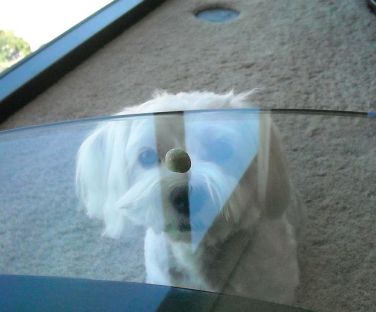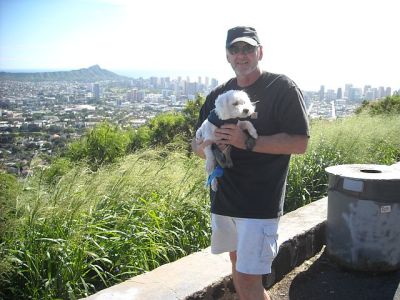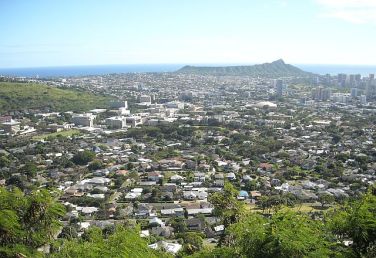Today, Max’s adventure took us to Pu’u Ohia, better known as Mount Tantalus.
It’s a lushly wooded, extinct volcanic cinder cone that was part of the immense Ko’olau Volcano that formed the southeastern part of our island of Oahu.
Tantalus was named in 1840 by kids from Punahou School while on a field trip.
Even now this elite school, President Obama’s alma mater, is where the smart, and/or rich, and/or lucky, kids go.
Not content with naming a Hawaiian cinder cone after a Greek dude, the Punahou kids proceeded to name the adjacent mountains and hills “Olympus”, “Round Top” and “Sugarloaf”.
Smart/rich/lucky, yes, but these privileged spawn were not paragons of cultural sensitivity and the mountain naming trip was a grim day for Hawaiian nomenclature.
The mythological Tantalus was a bad boy who committed a cornucopia of crimes depending on which version of his story you read.
Cannibalism, murder, and the flagrant promotion of Internet Explorer were all on his list of misdeeds.
Of all his unforgiveable transgressions, my favorite, because it ties into this blog’s theme, is that he stole a gold dog statue that was intended as a gift for the baby Zeus.
His punishment was to stand in a pool of water beneath a fruit tree with low branches. Whenever he reached for the fruit, the branches went up. Whenever he bent down to get a drink, the water went down. Bummer.
Thus Tantalus evolved to the English verb “tantalize”, the proverbial word for temptation without satisfaction.
Sort of like passing a microbrewery on the one day it is closed for renovations.
Or seeing Kim Kardashian’s latest photo spread when you don’t have a paddle.
But I digress.
As mounts go, it’s not very tall, rising to only 2,014 feet in America and only 614 meters in the rest of the world. It has long been a popular retreat for Honolulu dwellers seeking cooler temperatures, a rain forest-like atmosphere and great views.

The Kawanishi H8K was an Imperial Japanese Navy flying boat used during World War II for maritime patrol duties. The Allies called it an “Emily”.
During World War II, the US Army manned an artillery control station on Tantalus.
Not many folks know that the southern slope of the cinder cone was bombed by two Japanese Flying Boats during their failed second attack on Oahu (the first one was Pearl Harbor) on March 4, 1942.
If you never heard of this second attack, by all means click this link for a short recap of Operation K, a near text book example of what the Japanese have come to call “Murphy-san’s Law.”
There are numerous hiking trails on Mount Tantalus including a six mile loop trail that meanders through a forest of aromatic eucalyptus, guava, myrtle, shower trees, monkeypod, jacaranda and vast swaths of stag-horn ferns.
The hill is also popular with death-defying skateboarders, indefatigable bicyclists and joggers seeking a personal understanding of the term “myocardial infarction.”
The first home on Tantalus was built in 1880 and due to the challenging terrain, electricity was not available until the 1920’s, some 30 years after the bulk of Honolulu had service.
Although it is only 3 miles from downtown Honolulu, this misty and rugged area has no public water or sewer connection.
Instead, they rely on catchment systems to collect nightly rainfall and septic tanks or cesspools for waste disposal.
There are now about 150 private homes on the mountain and they will set you back from about $900,000 for a hovel to about $1,500,000 for a mere fixer-upper. To get a nice, move-in ready place will add another $1 – $2 million. Oh well, the lots are big by Hawaii standards.
There is a small State Park about halfway up Round Top Drive named Pu’u Ualaka’a.
It’s a wonderful spot to view the city of Honolulu and most all of the south shore of the island.
According to the local tale, Pu’u Ualaka’a means “hill of the rolling sweet potatoes.”
It was named by Kamehameha I who ordered sweet potatoes to be planted on the slopes. When they were dug up, they rolled down the hill.
Kamehameha I was a literal kind of guy when it came to place names.
He pretty much sucked at farming, too.
Dogs are not permitted at Pu’u Ualaka’a.
However, keeping with the spirit of Tantalus, we went rogue and simply ignored the signs, broke the law and thereby risked a future of standing in duplicitous water under malevolent fruit trees just so the Malt might experience the sights.
The road to the top of Mount Tantalus connects to the adjacent hill called Round Top so most folks make the drive into a loop.
There are numerous spots to stop along the road and a night drive to admire the city lights is a popular activity.
Younger folk will stop at the turn-outs for long periods of time to watch the nightly offshore submarine races, an activity which curiously fogs car windows.

There’s a little park in the Ualaka’a area that has an enormous Earpod Tree. Max lifted a leg, I merely posed.
On the lower slopes of Tantalus is the neighborhood of Papakolea, home to the largest concentration of Native Hawaiians in urban Honolulu.
In Papakolea, eighty-five percent of residents are full or part-Hawaiian.
To complete our loop we drove past a mini-park that has a giant earpod tree and we let the Malt get out and stretch his short legs.
All too soon we were home with Max sitting by the condo window, gazing up at the site of his most recent adventure and dreaming of the smell of rolling sweet potatoes in the morning.
Categories: Max's Stories











It’s like here. We can be in downtown Phoenix in 40 minutes (or the city line in five), but we haven’t sold out. We’re on septic. We can’t get water from the rain or dew-not enough. We have a well.
LikeLiked by 1 person
Yup, totally different from a moisture standpoint. The rock walls and even the roads high up on Tantalus are coated with a green moss from the constant mist and nightly rain while in your neck of the woods the rain evaporates before it hits the ground. I have some stories of life with a septic system but this is certainly not the place for me to expound on them, especially at meal times. 🙂
LikeLiked by 1 person
I don’t think he knows how good he’s got it. There are a lot of skycrapers in the backgrounds of these pictures. Are all of these apostrophes in Hawaiian words substituting for left-out letters? I’m so confused by Hawaiian lingo. Also, I understand that a gold bar is very heavy, so if Tantalus stole a gold dog statue, he must have been quite strong. Like Charles Atlas strong.
LikeLiked by 1 person
More info than you could possibly care about:
The good news is there are only 14 letters in the Hawaiian alphabet. But there are some special marks like the “okina” that looks like a backwards apostrophe. It signals what they call a “glottal stop” which is like saying “uh-oh!” in English where there is a distinct stop between the two sounds. In written Hawaiian that would (sorta) be uh’oh. There’s also a “macron” that looks like a line over a letter ( looks like ō) and that just means a long vowel sound. In Hawaii, English and Hawaiian are both official languages.
LikeLiked by 1 person
So which of the qualifications for admittance did Obama have?
Glad you gave Max a treat after his terrible ordeal.
LikeLiked by 1 person
Uh uh, nope, not gonna go there…hehehe.
Max says the small treat was inadequate compensation for the stress he endured. But he always exaggerates.
LikeLike
What an earnest face Master Maxwell has–great pic!
LikeLike
Amazing how they can fake it, isn’t it? There’s a lot of rascal hiding under that innocent expression.
LikeLike
Max chuckled as he tied you to the tree for that crummy ‘cookie on the wrong side’ trick, huh? Close, closer; now lift your leg, Max!
LikeLiked by 1 person
He found no humor at all in the glass table trick. Were it up to him I think I would still be at the tree.
LikeLike
Great blog and very informative. Max is adorable. 😄
LikeLike